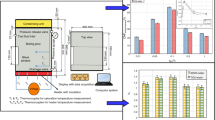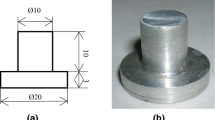Abstract
The pool boiling of R-134a has been experimentally investigated with an addition of nano particles of Aluminum oxide. The experiments were carried out using a cylindrical stainless-steel heater. The roughness of the heater surface was changed. Different concentrations of nano Aluminum oxide particles to the base R-134a were tested. Different heat fluxes as well as different boiling pressures were considered during the experimental tests. The results show that the suspension of Al2O3 nano particles enhances heat transfer coefficient in the nucleate pool boiling zone for concentrations ranging from 0.01 to 0.25% by volume. Higher heat flux and pressure result in enhancements of 37.6, 55.4, 90.2 and 167.7% corresponding to 0.042, 0.84, 1.54 and 2.35 μm surface roughness respectively. The more concentration of Al2O3 nano particles deteriorates the heat transfer coefficient. An empirical correlation was deduced to formulate the relation among heat transfer coefficient, heat flux, pressure, concentration, and surface roughness within a maximum deviation of about ±9%.









Similar content being viewed by others
Abbreviations
- C :
-
Specific heat [J/(kg K)]
- d :
-
Diameter of the heater (m)
- h :
-
Heat transfer coefficient [W/(m2 K)]
- i :
-
Electric current (A)
- k :
-
Thermal conductivity [W/(m K)]
- l :
-
Length of the heater (m)
- M :
-
Molecular mass (kg/k mol)
- \( m^{.} \) :
-
Mass flow rate (kg/s)
- p :
-
Pressure (Pa)
- n :
-
Shape factor, n = 3/τ
- q :
-
Heat flux (W/m2)
- R :
-
Heat ratio
- Ra :
-
Arithmetical mean of roughness profile (μm)
- Rp :
-
Maximum roughness peak height (μm)
- Rq :
-
Root mean square roughness average (μm)
- Rv :
-
Maximum roughness valley depth (μm)
- Rz :
-
Irregularities roughness height of ten points (μm)
- r :
-
Radius (m)
- ρ :
-
Density (kg/m3)
- σ :
-
Surface tension (N/m)
- T :
-
Temperature (K)
- τ :
-
Sphericity, τ = 1 for sphere, τ = 0.5 for cylinder
- v :
-
Voltage (V)
- ϕ :
-
Concentration by volume
- ξ :
-
Enhancement ratio
- avg :
-
Average
- bf :
-
Base fluid
- cr :
-
Critical
- i :
-
Inner
- o :
-
Outer
- mr :
-
Mirror
- nf :
-
Nano fluid
- np :
-
Nano particles
- p :
-
Pressure
- s :
-
Surface
- sat :
-
Saturation
- w :
-
Water
References
Eastman JA, Choi SUS, Li S, Yu W, Thomson LJ (2001) Anomalously increased effective thermal conductivities of ethylene glycol-based nano fluids containing copper nano particles. Appl Phys Lett 78(6):718–720
Sarafraz MM, Peyghambarzadeh SM, Fazel SAA, Vaeli N (2013) Nucleate pool boiling heat transfer of binary nano mixtures under atmospheric pressure around a smooth horizontal cylinder, periodica polytechnica. Chem Eng 57(1–2):71–77
Sarafraz MM, Pyghambarzadeh SM (2012) Nucleate pool boiling heat transfer to Al2O3–water and TiO2–water nano fluids on horizontal smooth tubes with dissimilar homogeneous materials. Chem Biochem Eng Q 26(3):199–206
Das SK, Putra N, Roetzel W (2003) Pool boiling characteristics of nano fluids. Int J Heat Mass Transf 46:851–862
Das SK, Putra N, Roetzel W (2003) Pool boiling of nano fluids on horizontal narrow tubes. Int J Multiph Flow 29:1237–1247
Bang IC, Chang SH (2005) Boiling heat transfer performance and phenomena of Al2O3–water nano fluids from a plain surface in a pool. Int J Heat Mass Transf 48:2407–2419
Suriyawong A, Wongwises S (2010) Nucleate pool boiling heat transfer characteristics of TiO2–water nano fluids at very low concentrations. Exp Therm Fluid Sci 34:992–999
Vassallo P, Kumar R, D’Amico S (2004) Pool boiling heat transfer experiments in silica–water nano fluids. Int J Heat Mass Transf 47:407–411
Sivakumar A, Alagumurthi N, Senthilvelan T (2016) Experimental investigation of forced convective heat transfer performance in nano fluids of Al2O3/water and CuO/water in a serpentine shaped micro channel heat sink. Heat Mass Transf 52:1265–1274
Doshmanziari FI, Zohir AE, Kharvani HR, Vahid DJ, Kadivar MR (2016) Characteristics of heat transfer and flow of Al2O3/water nano fluid in a spiral-coil tube for turbulent pulsating flow. Heat Mass Transf 52:1305–1320
Trisaksri V, Wongwises S (2009) Nucleate pool boiling heat transfer of TiO2–R141b nano fluids. Int J Heat Mass Transf 52:1582–1588
Liu DW, Yang CY Effect of nano particles on pool boiling heat transfer of refrigerant 141b, ICNMM2007-30221, Puebla, Mexico
Tang X, Zhao YH, Diao YH (2014) Experimental investigation of the nucleate pool boiling heat transfer characteristics of d-Al2O3–R141b nano fluids on a horizontal plate. Exp Therm Fluid Sci 52:88–96
Peng H, Ding G, Hu H (2011) Effect of surfactant additives on nucleate pool boiling heat transfer of refrigerant-based nano fluid. Exp Therm Fluid Sci 35:960–970
Sayahi T, Bahrami M (2016) Investigation on the effect of type and size of nano particles and surfactant on pool boiling heat transfer of nano fluids. Tran ASME 13:031502-2
Kamatchi R, Venkatachalapathy S, Nithya C, Experimental investigation and mechanism of critical heat flux enhancement in pool boiling heat transfer with nano fluids. Heat Mass Transf doi:10.1007/s00231-015-1749-2
Sarafraz MM, Hormozi F, Silakhori M, Peyghambarzadeh SM (2016) On the fouling formation of functionalized and non-functionalized carbon nano tube nano fluids under pool boiling condition. Appl Therm Eng 95:433–444
Jabardo JMS, Ribatski G, Stelute E (2009) Roughness and surface material effects on nucleate boiling heat transfer from cylindrical surfaces to refrigerants R-134a and R-123. Exp Therm Fluid Sci 33:579–590
Mitutoy, Portable surface roughness tester SURFTEST SJ-210 Series, Bulletin No. 2140
Xuan Y, Li Q (2000) Heat transfer enhancement of nano fluids. Int J Heat Fluid Flow 21:58–64
Hamilton RL, Crosser OK (1962) Thermal conductivity of heterogeneous two component systems. Ind Eng Chem Fundam 1(3):187–191
Mahbubul IM, Saadah A, Saidur R, Khairul MA, Kamyar A (2015) Thermal performance analysis of Al2O3/R-134a nano refrigerant. Int J Heat Mass Transf 85:1034–1040
Subramani N, Prakash MJ (2011) Experimental studies on a vapour compression system using nano refrigerants. Int J Eng Sci Technol 3(9):95–102
Raveshi MR, Keshavarz A, Mojarrad MS, Amiri S (2013) Experimental investigation of pool boiling heat transfer enhancement of alumina–water–ethylene glycol nano fluids. Exp Therm Fluid Sci 44:805–814
Holman JP (2001) Experimental methods for engineers, 7th edn. McGraw-Hill, New York
Narayan GP, Anoop K, Das SK (2007) Mechanism of enhancement/deterioration of boiling heat transfer using stable nano particle suspensions over vertical tubes. J Appl Phys 102:074317
Cooper MG (1984) Saturation nucleate pool boiling—a simple correlation. In: 1st UK Natl. Heat Transfer Conf. (I. Chem. E. symposium series no. (86) vol 2, pp 785–793
Park KJ, Jung D (2007) Enhancement of nucleate boiling heat transfer using carbon nano tubes. Int J Heat Mass Transf 50:4499–4502
Park KJ, Jung D (2007) Boiling heat transfer enhancement with carbon nano tubes for refrigerants used in building air-conditioning. Energy Build 39:1061–1064
Author information
Authors and Affiliations
Corresponding author
Rights and permissions
About this article
Cite this article
Eid, E.I., Khalaf-Allah, R.A., Taher, S.H. et al. An experimental investigation of the effect of the addition of nano Aluminum oxide on pool boiling of refrigerant 134A. Heat Mass Transfer 53, 2597–2607 (2017). https://doi.org/10.1007/s00231-017-2010-y
Received:
Accepted:
Published:
Issue Date:
DOI: https://doi.org/10.1007/s00231-017-2010-y




